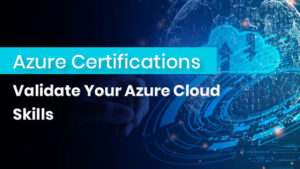
How to Harden Your Infrastructure Using CIS Benchmarks
How to Harden Your Infrastructure Using CIS Benchmarks Introduction As more organizations go faster with their digital transformation, the security and resilience of IT infrastructure
Limited-Time Offer! Get an exclusive 40% OFF on IPSpecialist Premium Monthly & Annual Plans. Use Promo Code: UPSKILLNOW at checkout.

How to Harden Your Infrastructure Using CIS Benchmarks Introduction As more organizations go faster with their digital transformation, the security and resilience of IT infrastructure

Azure Certifications – Validate Your Azure Cloud Skills Introduction Cloud computing has transformed the business landscape, providing scalability, flexibility, and affordability in a way

Top Cyber Security Trends: What Every Organization Must Know Introduction In an era marked by digital transformation, remote workforces, and rapidly evolving threat landscapes,
Table of Contents
Enterprises can secure their data and cloud-based applications with the help of a Cloud Access Security Broker (CASB) software solution. CASBs can be used to enforce security regulations, keep an eye on user behavior, and stop information breaches.
Cloud Access Security Brokers (CASBs), on-premises or cloud-based enforcement points for enterprise security policies, aggregate and insert enterprise security policies as cloud-based resources are accessed. CASBs combine many forms of security policy enforcement.
Examples of security policies include single sign-on, authentication, authorization, mapping credentials, device profiling, encryption, tokenization, logging, alerting, and malware detection/prevention. This article covers detailed knowledge of Cloud Access Security Brokers (CASBs).
Check out our Courses now if you are considering pursuing a career in Cloud Computing, Networking, and Cybersecurity!
These serve as the basic pillars of every CASB solution. For a program to be effective, all pillars must be present.
This may entail giving users on corporate devices full access to a licensed suite like Microsoft 365 while only providing web-only email to users on unmanaged devices.
Compliance is a crucial consideration for businesses when deciding whether to move their data and systems to the cloud. These compliance regulations protect the company’s security and personal data, so ignoring them could lead to risky and expensive breaches.
Accuracy is attained using context to lessen the detection surface area and extremely sophisticated cloud DLP detection techniques like document fingerprinting. When sensitive content is discovered in or on its way to the cloud, the Cloud Access Security Broker (CASB) should enable IT to swiftly move suspected violations to their on-premises systems for extra analysis.
A CASB can protect a business from many malware and cloud threats. Threats that combine prioritized static and dynamic malware analysis for advanced threat intelligence must be avoided at all costs. The shield might be the appropriate defense against these threats because some risks may come from cloud services.
These architectural elements come together below to form a cloud access security broker solution:
The IT infrastructure parts on the main organizational campus are part of the immediate corporate core. This refers to office and datacenter settings that the organization owns and runs.
The components nominally owned by the organization but located elsewhere are referred to as the secondary core.
PaaS is a cloud component that enables businesses to create and use apps without having to interface with the company premise. All the computing power required to create and maintain apps is made available via PaaS monthly.
IaaS refers to cloud components that imitate on-premise hardware like storage and network appliances. IaaS, in contrast to PaaS, is typically offered by a public cloud provider like AWS or Microsoft Azure. IaaS is used by businesses to run their daily operations and support their PaaS applications.
SaaS is the architectural element of a cloud access security broker implementation plan that is growing fastest. All enterprise users’ cloud-based apps, which may be spread across many cloud environments, are referred to by this term.
The connectivity gateway lets users create connections between various cloud components and the company core. A cloud access security broker typically has an auto-discovery feature that enables it to recognize any cloud service communicating with the company. The cloud access security broker will highlight each component and increase visibility even if the cloud environment is not completely mapped. Additionally, the connectivity gateway streamlines the process of adding new parts and cloud services so users can easily manage the entire landscape.
The two types of business rules that cloud access security brokers support are pre-configured and dynamic rules. A group of users permitted access to a specific cloud service can be banned and allowed according to pre-configured rules. Business rules that employ contextual data to grant or restrict access are called dynamic rules.
Typically, pre-configured and established compliance requirements are based on the rules and laws applicable to a particular cloud location. Machine Learning (ML) is a common technique used by dynamic security solutions to increase their effectiveness over time. These regulations are put into effect throughout the internal organization’s cloud environments and are stored on the cloud access security broker.
Data can move securely in both directions between the company and the cloud with the help of a cloud access security broker.
The architectural aspect of traffic is what the cloud access security broker seeks to moderate. Information, procedures, and workflows will be continuously transferred to and from the cloud in a modern enterprise environment.
Every user access event and policy modification is recorded by a cloud access security broker, and important trends from these logs are reported via analytics insights.
Implementing a cloud access security broker is mostly done to promote integration and strengthen cloud security. However, an organization has numerous other use cases for cloud access security brokers.
Brokers for cloud access security can be pre-configured with risk and compliance requirements specific to the company, sector, and location. One example is Microsoft CASB, which supports over 70 risk variables and is a component of the Microsoft Defender package. The cloud access security broker rates each cloud application and service’s risk after comparing it to the pertinent parameters. To properly manage risk, IT administrators can balance a service’s risk level against its utilization and significance.
Duplicate cloud services for the same task may exist for two reasons. Without informing the IT department, different teams and employees could install multiple SaaS apps, leading to overlapping. Inadvertent duplication can also result from organic organizational growth and modifications to IT resources. The cloud access security broker will draw attention to situations where there are multiple apps for a given activity, wasting resources and increasing security threats.
They offer full transparency into corporate data kept in the cloud, outlining its location, access rights, compliance framework, and vulnerabilities. Users can also set up rules that send notifications whenever an unauthorized program or service tries to access business data. This stops data exfiltration and guarantees that only people with permission can access sensitive data.
SaaS, PaaS, and IaaS IT infrastructures risk becoming fragmented in compliance and security. It becomes challenging for the central IT staff to manage the entire environment when different teams and regions may implement inconsistent policies.
Large amounts of business information are now shared through cloud-based collaboration technologies like Slack, Dropbox, and Office 365. Users can extend data protection and compliance regulations to these apps by using cloud access security brokers. It can prevent sensitive data from being downloaded to local devices and automatically check files when they are submitted to cloud apps.
The CASB products from Forcepoint cover many use cases, including Cloud Governance for application visibility and risk assessment, Cloud Audit & Protection for real-time activity monitoring and analytics, and other use cases, including DLP and discovery. With the addition of Bitglass and Imperva’s technology, Forcepoint has expanded its CASB product line.
The CASB solutions from Iboss are especially beneficial for cloud apps from Google, Microsoft, and social media.
Lookout has several cutting-edge CASB features, including DLP, UEBA, zero trust, integrated endpoint security, and more, due to the acquisition of CipherCloud.
Netskope, a long-time leader in CASB technology, maintains continuous security review and compliance.
Cloud service providers are currently running extremely secure operations. In fact, most security failures are caused by customer security errors rather than cloud service provider security issues.
Customers do not need to worry about storing their data in the cloud because future-proof cloud service security is guaranteed. Indeed, with CASBs, the most comprehensive threat assessment, protection, and remediation are now available, elevating cloud usage to new heights and making it the most secure way for an organization to handle its data.
Any cloud security strategy must include Cloud Access Security Brokers (CASBs). A centralized point of control for managing and securing access to cloud apps and data is offered by CASBs. They provide a range of features, such as user and entity activity analytics, granular access control, and data loss prevention, to assist enterprises in meeting their security and compliance needs.
© 2025 All rights reserved | Privacy Policy | Terms and Conditions | Sitemap | Cookie Policy




